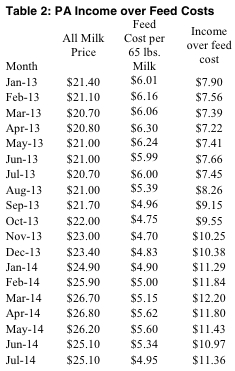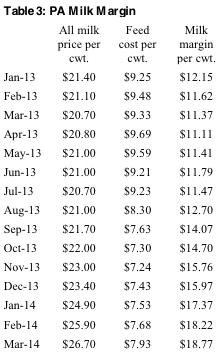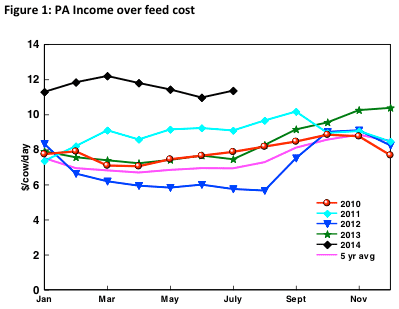
The prices of all dairy products have been mixed since last month. The CME block cheese price took a roller coaster ride, first dipping to $1.95/lb., then climbing rapidly to $2.04, dipping to $1.96, and finally ending at $2.06, up 4.7% net. This higher cheese price of course is reflected in the higher Class III price for both July and for the August futures (see below). CME butter prices followed a somewhat similar path, ending essentially where they were last month, despite having risen to $2.62 in the third week of July. The CME butter price is now $2.40/lb. With butter and cheese inventories well below last year's levels, despite the continuing strong exports and a strengthening economy, prices seem likely to be higher in the fall than seemed likely a few months ago. The CME skim-milk powder price fell by 3.5¢/lb. since the last report, with the dry whey price unchanged. These changes mean both the Class III and Class IV prices for July were higher than the prices predicted on July 3, and the futures prices for the rest of 2014 are also up.
Table 1 lists some past and estimated future milk prices. The July Pennsylvania all- milk price matched June at $25.10/cwt. The latest milk production growth report was moderate, but milk futures prices are still lower for the remaining months of 2014, although somewhat higher than last month. The July Class III price was $0.24 above June at $21.60/cwt. The latest Class III futures price for August is $21.76. The average Class III futures prices for the remaining five months of 2014 are $2.50 above 2013 prices for the same months at $20.91. The July Class IV price was up $0.65/cwt. from June at $23.78/cwt. The prices for Class IV futures average $20.97/cwt. for the rest of 2014, down from last month. While Class IV prices rose in late 2013, for the rest of 2014 they are expected to edge lower. Recent PA all-milk prices and the forecast prices for the rest of 2014 based on the futures prices are also shown in Table 1. The forecast all-milk prices for the rest of 2014 average $24.00/cwt., or $1.78/cwt. above the same period of 2013. Milk production is expected to continue to grow for the rest of 2014 in response to better margins.
The U.S. dollar is up against the Euro and the Australian and New Zealand dollars since my last report, especially against the New Zealand dollar, the major dairy exporting country. The recent reports of higher growth in U.S. Gross Domestic Product and other aspects of the economy have strengthened the dollar.
Corn and Soybean Markets
Corn prices have fallen 13.9% since the last report, ending at $3.59/bu. for the September 2014 contract. Growing conditions in the Midwest were very favorable in July, with the average July temperature in July tying the low attained in 2009. Conditions are a little dry now, but, given the wet June, not yet serious. Soybean prices are down 11.2% from last month, reflecting the expectation of an excellent crop on more acreage than last year. Soybean meal is down 13.2% from last month. In total, the purchased feed prices should be more affordable for dairy producers, although the drought in the West continues to worsen.
Income over Feed Costs (IOFC)
Penn State's measure of income over feed costs rose by 3.5% in July, still well above last year. Figure 1 shows how these values compare to recent years. This month's feed cost decrease is 39¢/cow/day. July's value for IOFC of $11.36/cow/day is $3.91/cow/day above the July 2013 value for this measure. The PA all-milk price was unchanged in July, but the feed costs fell by 7.25%, with lower prices for soybean meal, corn, and hay. The cost of feeding a cow fell by 39¢/day to $4.95. Income over feed cost reflects daily gross milk income less feed costs for an average cow producing 65 pounds of milk per day. Figure 1 and Table 2 showing the monthly data follow.
The allocation of the revenue per hundred pounds of milk is shown in Table 3. The milk margin is the estimated amount from the Pennsylvania all milk price that remains after feed costs are paid. Like income over feed cost, this measure shows that the July PA milk margin was 3.5% higher than in June.
Milk Production
The latest milk production report showed June milk production up 1.95% from the year earlier, the largest monthly increase this year over the same month of 2013 (Figure 2). This is somewhat bearish, although given the margins so far in 2014, it is not excessive. The biggest growth was in the West, while the traditional Great Lakes dairy states grew less. Monthly milk production in each of Minnesota, Pennsylvania, New York, and Wisconsin was less than 1% more than June of 2013, while Idaho was 2.1% more, California up 1.7%, and Texas up by 8.3%. Cow numbers were not collected during this period in 2013, but the monthly numbers are shown in Figure 3. Cow numbers have been increasing very slowly, less than 0.2% per month, no doubt a reflection of the high value for cull cows.







8.6.14